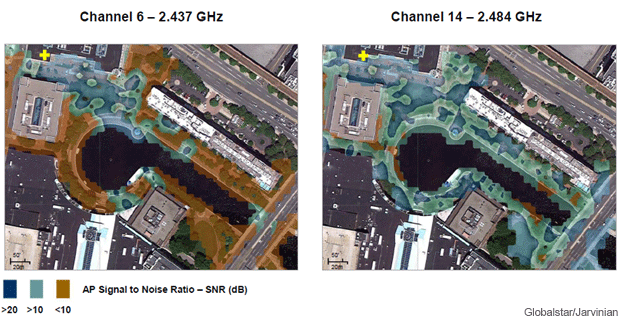Tapping satellite spectrum could greatly expand, improve Wi-Fi service

Globalstar and research organization Jarvinian have successfully tested Terrestrial Low Power Service, which adapts satellite communications spectrum for Wi-Fi.
Globalstar and Jarvinian are moving toward reducing the clogs on existing Wi-Fi networks with a successful test of the experimental Terrestrial Low Power Service (TLPS).
The wireless spectrum available for use today is becoming increasingly crowded, forcing technologies such as devices using the new IEEE 802.11ac standard to push into new bands just to be heard over the all the noise. President Obama even named wireless advancement a national priority in the "Unleashing the Wireless Broadband Revolution" presidential memorandum this month.
Globalstar has long been known for its satellite phones, but it also licenses a large portion of the wireless spectrum not normally used for terrestrial communication. The company teamed up with research organization Jarvinian to try and use that bandwidth to enhance the existing wireless spectrum.
The Jarvinian tests of TLPS were conducted with new carrier-grade equipment manufactured by Ruckus Wireless, a global supplier of advanced wireless systems. By all accounts, the testing was a successful proof of concept.
The tests demonstrated that deploying a managed 802.11-compliant technology over Globalstar’s licensed satellite spectrum with adjacent unlicensed ISM (industrial, scientific and medical) spectrum resulted in the creation of a service that exceeded the performance of public WI-Fi. All tests were performed over a new 22 MHz channel within the 2.4 GHz band using Ruckus Wireless and existing smart phones that were enabled to operate over the new channel via a remote firmware upgrade. The tests also demonstrated how quickly TLPS could be deployed to expand the nation’s wireless capacity.
All tests were conducted based on an experimental license issued by the Federal Communications Commission. FCC is considering Globalstar’s November 2012 petition to use its licensed spectrum terrestrially to support mobile broadband applications throughout the United States. "We appreciate the work of the Federal Communications Commission’s Office of Engineering and Technology in issuing the experimental licenses that we needed to test and prove the tremendous potential that this service holds for a mobile-driven public," said Jay Monroe, Chairman and Chief Executive Officer of Globalstar.
Most wireless devices operating in the 2.4GHz spectrum are divided into channels between 1 and 11, with most functioning on channels 1, 6 or 11. The TLPS equipment works basically the same way, but on Channel 14, which current devices can't reach. This means that the testing, and TLPS as it currently stands, could not interfere with existing wireless networks.

Channel 14 SNR comparison in semi-urban survey
“The combination of the Ruckus Smart Wi-Fi equipment and TLPS exceeded our expectations for distance and capacity while not interfering or degrading the existing traffic on traditional Wi-Fi channels,” said John Dooley, Jarvinian’s managing partner. “Even in an indoor urban environment made difficult or otherwise unusable by spectral congestion, usable connections were established at three to five times the distance of public Wi-Fi. More critically, very high-speed connections were maintained much more uniformly and over significantly longer distances.”
If TLPS ultimately is approved, devices will either need to be created, or firmware upgraded if possible, to take advantage of the new channel.
"There’s an insatiable demand for wireless capacity, whether in the licensed or unlicensed band," said Bart Burstein, senior vice president of field operations and business development for Ruckus Wireless. "The technical advances we have made in managing Wi-Fi signals to maximize performance enable us to support industry efforts, like those of Globalstar, to creatively help solve the wireless capacity crunch."
Globalstar officials say they won't be leaving the satellite communications business anytime soon, but are looking forward to the next phase of TLPS testing, which will involve the public, in an effort to reduce wireless congestion and bring the United States a bit closer to a nationwide Wi-Fi network.





